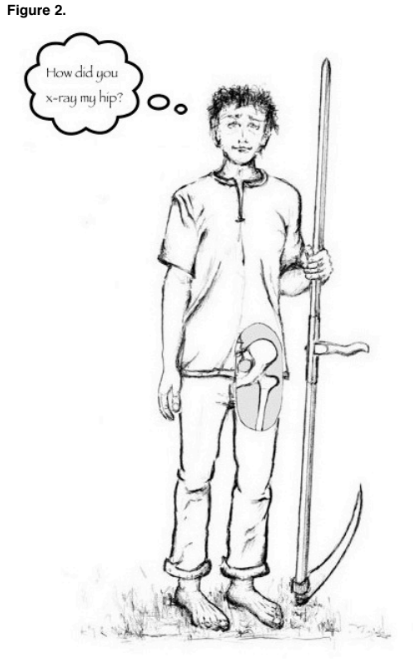The importance of a custom fit
To contradict a popular misconception – this old farm implement is far from “simple”. As
opposed to tools like a machete, a shovel or an ax, various versions of which can be used
successfully by almost anyone regardless of their height, for the scythe to function at its best
calls for a custom-fit snath with a well-matched blade. Although many tool users intuitively
grasped the concept of ergonomics for centuries before the term became popularized, in
plenty of instances it was not actually implemented – possibly because under certain
circumstances it would slow down the process of getting the job done. Instead, mowers often
sacrificed comfortable working posture. Suffice it to say that many thousands of hectares
have been cut with what we now consider poorly designed and/or wrongly sized snaths. In
many cases such shortcomings continue.
Ideally, the snath should fit the mower in such a way that postural integrity does not need to
be compromised in order to maintain a suitable angle between the blade’s edge and the
ground. One’s back should be able to remain relatively straight (though not stiff), with the
shoulders relaxed, and the hands at a favourable task-related distance from each other.
What constitutes a suitable edge-to-ground angle (the blade’s “Lay”) will be discussed in
Chapter 5.
Ergonomic design aside for now, it would be helpful to differentiate between snaths specific
to at least two purposes. On this count we believe that most people who use a scythe under
diverse conditions would be best served by having one of each size of snath, and
(preferably) a blade or two for each snath.
The two basic snath sizes are:
A. The “trimming” snath – for mowing in tight spaces (between closely planted trees, small
fruit bushes, vineyards, and along garden borders) or on uneven terrain. We recommend that
blades 65 cm or shorter be used with this size of snath.
B. The “field mowing” snath – for cutting larger and more open areas. Field snaths are most
often fitted with blades 70 cm or longer.
If the scythe is to be used on a more or less level terrain, the right-hand grip of a trimming
scythe (with the blade already mounted and touching the ground) stood along side of the
body, should reach to the bump marking the top of the femur: the place where the hips are
usually widest. In the case of a field scythe that grip should be positioned at least 5-6 cm
higher. Some individuals prefer their grip even farther from the lower end of the snath. For
instance, the fellow in Figure 2 is posing with his “field” snath, on which the (only) grip is more than 10 cm above his hip joint (nearing the level of the iliac crest which defines the top of the hips).
If the snath has two grips, the minimum distance between them should be the length of the
user’s forearm (from elbow to fingertips, referred to as “cubit”) for the trimming scythe, and 5-
10 cm longer than that for a field scythe. Thus, a snath with fixed grips may be well suited for
one OR the other of those types of tasks, but not both. One can opt for a compromise: a
“multi-tasking” snath – one with a shaft just long enough for the average person’s height, with
grips either somewhat adjustable or positioned approximately halfway between the
respective distances presented in the example above, and fitted with a mid-length (65-70 cm)
blade. Of course, there are situations where a scythe of this sort is what an experienced
mower, given the choice, would actually find most suitable. On the whole, however, it would
be helpful if more attention was paid to the issues of a niche- and person-specific fit than had
been practiced throughout the past when the luxury of owning multiple task-specific versions
of a tool – any tool – was simply not an option.
Additional pointers: While mowing on slopes for extended periods, we recommend the
following:
a) If mowing uphill (the more body-friendly approach to a slope, but not always practicable),
the distance between the blade and the lower grip should be shorter than what we
recommend for level terrain.
b) If mowing downhill (which is advisable when the vegetation leans that way) the distance
between the blade and the lower grip should be longer, to prevent needless bending forward.
In either case, if the snath has two grips, it will be more comfortable if the distance between
the grips is greater than it is on a field snath.
The One-Grip (‘Eastern’) Snath
A snath with a single grip (fixed approximately in the middle of the shaft’s length) is the most
widely used, both historically and today. It is the simplest to make and more forgiving when it
comes to blade/snath fitting. It also alleviates a portion of the sizing challenge addressed
above, because the distance between grips is a non-issue.
The length of a single-grip snath is about the same as the user’s height for the ‘trimming’
snath, and 10 or so cm longer for the ‘field’ snath, with the grip attached near the midpoint
in both respective cases. In use, the left (upper) hand holds the shaft most often with the
palm up. The design allows that same hand to easily slide – at a moment’s notice – to
whatever point on the shaft feels most comfortable under varying circumstances. This snath
can also be wielded quite efficiently with the left hand facing palm down, which is
advantageous in some terrain (steep hillsides) or situations (mowing competition sprints).
See Chapter 11 for guidelines on making these ‘Eastern’ style snaths.



